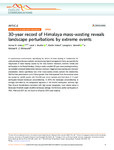30-year record of Himalaya mass-wasting reveals landscape perturbations by extreme events
| dc.contributor.author | Jones, JN | |
| dc.contributor.author | Boulton, Sarah | |
| dc.contributor.author | Stokes, M | |
| dc.contributor.author | Bennett, GL | |
| dc.contributor.author | Whitworth, MRZ | |
| dc.date.accessioned | 2022-11-01T12:16:53Z | |
| dc.date.issued | 2021-11-18 | |
| dc.identifier.issn | 2041-1723 | |
| dc.identifier.issn | 2041-1723 | |
| dc.identifier.other | 6701 | |
| dc.identifier.uri | http://hdl.handle.net/10026.1/19815 | |
| dc.description.abstract |
In mountainous environments, quantifying the drivers of mass-wasting is fundamental for understanding landscape evolution and improving hazard management. Here, we quantify the magnitudes of mass-wasting caused by the Asia Summer Monsoon, extreme rainfall, and earthquakes in the Nepal Himalaya. Using a newly compiled 30-year mass-wasting inventory, we establish empirical relationships between monsoon-triggered mass-wasting and monsoon precipitation, before quantifying how other mass-wasting drivers perturb this relationship. We find that perturbations up to 5 times greater than that expected from the monsoon alone are caused by rainfall events with 5-to-30-year return periods and short-term (< 2 year) earthquake-induced landscape preconditioning. In 2015, the landscape preconditioning is strongly controlled by the topographic signature of the Gorkha earthquake, whereby high Peak Ground Accelerations coincident with high excess topography (rock volume above a landscape threshold angle) amplifies landscape damage. Furthermore, earlier earthquakes in 1934, 1988 and 2011 are not found to influence 2015 mass-wasting. | |
| dc.format.extent | 6701- | |
| dc.format.medium | Electronic | |
| dc.language | en | |
| dc.language.iso | en | |
| dc.publisher | Nature Research | |
| dc.title | 30-year record of Himalaya mass-wasting reveals landscape perturbations by extreme events | |
| dc.type | journal-article | |
| dc.type | Journal Article | |
| dc.type | Research Support, Non-U.S. Gov't | |
| plymouth.author-url | https://www.webofscience.com/api/gateway?GWVersion=2&SrcApp=PARTNER_APP&SrcAuth=LinksAMR&KeyUT=WOS:000720682300076&DestLinkType=FullRecord&DestApp=ALL_WOS&UsrCustomerID=11bb513d99f797142bcfeffcc58ea008 | |
| plymouth.issue | 1 | |
| plymouth.volume | 12 | |
| plymouth.publication-status | Published online | |
| plymouth.journal | Nature Communications | |
| dc.identifier.doi | 10.1038/s41467-021-26964-8 | |
| plymouth.organisational-group | /Plymouth | |
| plymouth.organisational-group | /Plymouth/Faculty of Science and Engineering | |
| plymouth.organisational-group | /Plymouth/Faculty of Science and Engineering/School of Geography, Earth and Environmental Sciences | |
| plymouth.organisational-group | /Plymouth/REF 2021 Researchers by UoA | |
| plymouth.organisational-group | /Plymouth/REF 2021 Researchers by UoA/UoA07 Earth Systems and Environmental Sciences | |
| plymouth.organisational-group | /Plymouth/Research Groups | |
| plymouth.organisational-group | /Plymouth/Research Groups/Marine Institute | |
| plymouth.organisational-group | /Plymouth/Users by role | |
| plymouth.organisational-group | /Plymouth/Users by role/Academics | |
| dc.publisher.place | England | |
| dcterms.dateAccepted | 2021-10-25 | |
| dc.rights.embargodate | 2022-11-2 | |
| dc.identifier.eissn | 2041-1723 | |
| dc.rights.embargoperiod | Not known | |
| rioxxterms.versionofrecord | 10.1038/s41467-021-26964-8 | |
| rioxxterms.licenseref.uri | http://www.rioxx.net/licenses/all-rights-reserved | |
| rioxxterms.licenseref.startdate | 2021-11-18 | |
| rioxxterms.type | Journal Article/Review |


